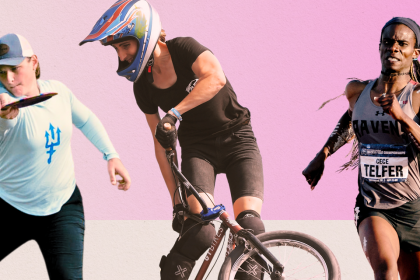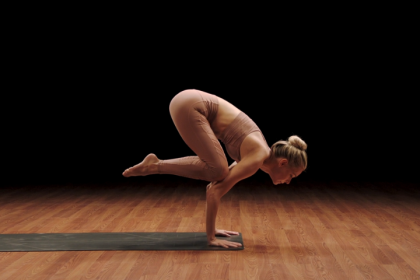Fitness was a different beast when I started lifting in college: The weight room was pretty much all dudes, folks worked out in old cotton T-shirts, and the only exercise info you could find came from monthly print mags that also served up a hefty dose of diet culture.
Today, there’s tons of fitness content at your fingertips, which sounds great in theory but also…isn’t. Now more than ever, misinformation abounds. Social media, in particular, is flooded with posts about supplements that’ll “boost your gains” and workout programs designed to “tone you up” in six weeks or less. And if you’re new to exercise, it’s really easy to internalize all this as gospel: what you need to do, eat, and believe if you want to be “fit.”
I should know: I spent a lot of time abiding by so much of the (trash) fitness dogma of the day when I was starting out. But nearly 20 years later—with a personal training certification and a role as SELF’s fitness director to show for it—I’ve honed a more holistic understanding of what a healthy routine should look and feel like. Parts of the path were bumpy, sure, and I don’t profess to know all the answers, but the process of honing my relationship with movement left me with a bunch of takeaways that would have been so helpful way back when. Here are all the fitness truths I wish I knew in my 20s—if you’re feeling a little lost, demotivated, or frustrated about how fitness fits into your life, I hope they can help you too.
1. Tease out your interests—and don’t be ashamed of them.
For a fitness program to “work”—say, maybe you want to build muscle and get stronger or go about your everyday life with fewer aches—you have to do it regularly. And if you’re going to make exercise a habit, you have to…not hate doing it. Finding a form of movement you honestly enjoy is key, and if it doesn’t match up with the workouts you’re seeing all over social? Oh well! If you’re happier doing a lifting routine while all the TikTok girlies are talking up Pilates, put down the Magic Circle and pick up your barbell! Your choice is no less valid even if it seems to be the less trendy one.
2. Starting to lift weights is hard, but you can’t beat the weeks that come after it.
The movements can definitely feel awkward at first. Maneuvering and balancing the weights, trying to stay stable, and keeping your form in check can also be a bit overwhelming, which makes the first few weeks not so fun. But if you push through it, you’ll quickly be met with “newbie gains,” a term used to describe the rapid increase in strength that follows the start of a lifting program. Thanks to new neural adaptations in your brain and your body (which are directly responsible for allowing you to lift heavier), you’ll probably experience the greatest and quickest spike in strength that you’ll ever have. Enjoy it!
3. Nobody cares.
When Alexis Rose from Schitt’s Creek said this exact line to her brother David, who was stressing over passing his driver’s test, she meant it the same way I do: in the kindest way possible. “People aren’t thinking of you the way you’re thinking about you,” she told him. Just as David’s instructor wasn’t going to fixate on his every move, the people at the gym or in the park you like to run in aren’t giving that much attention to what you’re doing, promise. It can feel like all eyes are on you, especially if you’re new and don’t feel comfortable in that space yet, but in reality, people are way more focused on what they’re doing to pay anyone else much mind.
4. Get a good pair of shoes.
And target them to your intended activity. I spent a few years lifting in my running shoes, and I can tell you: The curved rocker bottom that helps you push off on the roads only leads to wobbling on the gym floor. You need a shoe with a flat bottom that allows you to push through the floor on big lower-body moves like deadlifts and lunges. Meanwhile, if you prefer to start with walking or running, that’s when you’ll probably appreciate more of a cushion to blunt the impact of all that pounding.
5. Master the basics.
Sure, there are more than a dozen ways to do a squat and so many variations of downward dog, but before you try all of them at once, focus on perfecting the OG move. The basics serve as a solid foundation, whether you want to switch them up down the line or simply continue to get better and better at them. Nearly 20 years into lifting, my regular routine is still heavily weighted in favor of the basics: deadlift, bench press, overhead press, and lunges.
6. Learn how to use your gym’s equipment.
Even the intimidating stuff. In the beginning, I spent so much time sticking to equipment I couldn’t screw up, like the elliptical machine or the dumbbells. So I missed out on things that intrigued me, like the power cages (key for pretty much any barbell move) and the cable machines (awesome for pulling). If you don’t feel comfortable learning while the floor’s in full swing—remember though, nobody cares, David—make a separate trip during a dead time (at my gym, after 8 p.m. was golden) and give yourself free rein to play around. Adjust the machines, switch out attachments, whatever is calling to you. And if you’re feeling really lost, it’s also a great time to chat with the front desk workers about any machines you’re still not sure about.
7. That sports bra and shorts set you’ve been eyeing? Buy it.
And wear it proudly—believe me, it looks great on you!
8. Sometimes boring is better.
So many influencers shake up their workouts from week to week, claiming that “muscle confusion”—keeping your body guessing with different loads and stimuli—is the secret to great gains. But in reality, constantly reinventing your routine makes it hard to see progress, since you can’t really progressively overload your muscles (which just means continually challenging them with more and more work). If your goal is simply moving your body and not getting bored, go ahead and switch up your workouts as you see fit, but if you have performance metrics in mind, try to stick with your plan for about six weeks before tweaking it. I used to program hop all the time, and it wasn’t until I stayed the course that I started to get stronger.
9. Give your entire body some love.
Despite what you might see on social, a solid strength training plan involves more than just butt exercises. It’s easy to focus on just one part of your body if you’ve got specific goals (or you simply enjoy working certain areas more than others), but spreading the love helps build the balanced strength that allows you to do everything more safely and effectively. Dipping your toe in other modalities—say, cardio for your heart or yoga for mobility—can only help too. You’ll thank yourself once you hit your 30s (and beyond).
10. You probably need to take a longer breather between sets.
One of the biggest fallacies in fitness is equating sweat with a successful workout. But if you want to get stronger or build muscle, in particular, constantly trying to keep your heart rate high is actually hindering those gains. That’s because your muscles will have a really hard time pushing through more and more work if you don’t take a beat to recover in between sets. So resist the urge to go right from one exercise to the other. Instead, after each set, give yourself time to breathe and let your heart rate come down. That means resting for at least a minute between sets if you’re working with moderate loads, and up to three to five if you’re going heavy. I get it: It might feel like you’re “wasting” time at first, but these breaks really are the most important part; otherwise, you run the risk of tiring your muscles out before they can do their very best.
11. And you don’t need to pack your workout with quite so many exercises either.
Even if you’re resting as much as you should, your muscles still aren’t going to bring their A-game if you ask them to do way too many things. I used to cram a boatload of exercises into my routine, making for long—and not terribly effective—workouts. But as I learned over time, quality beats quantity every single time: Evidence suggests that just 4 to 12 sets per week per muscle group are effective for building strength and muscle. That can shake out to just one to two exercises per area each session (maybe one day you work your quads and shoulders with a goblet squat and overhead press, then you do lunges and lateral raises on another) if you’re exercising a couple times a week. You want your muscles fresh enough to do the most work they can, whether you’re adding more weight or more reps. So pick four or five exercises, go hard on them, and call it a day.
12. You’re not going to feel jazzed about every single workout.
It doesn’t mean fitness isn’t for you if you don’t jump into every workout with boundless enthusiasm. No one feels motivated every time. But it’s important to tease out when you’re dealing with simple inertia (you know, the feeling that usually shakes off as soon as you get your blood flowing) versus a real physiological or mental need to dial it back (say, when you have bodywide fatigue or soreness).
13. Chasing a smaller body can have legit repercussions down the line.
So many folks go through the phase of wanting to look a certain way, and in many cases, that means “smaller.” There are tons of reasons to resist this, but one that I really wish I had known earlier: The chronic strain food restriction, overtraining, or any combo of the two puts on your body can have effects that don’t come to light until years later, like weakened bones, a higher risk of stress fractures, hormonal irregularities, and body image issues that easily seep into life outside the gym.
14. A lot of what you see on fit-fluencer social feeds is smoke and mirrors.
You can’t compare your results to their results. Sure, everyone’s body is different, so what affects one person one way might not necessarily do the same for another. But you don’t really know—and will never really know—if a fit-fluencer is truly doing the things they show themselves doing. The workout plan they’re hocking probably isn’t solely responsible for them looking or performing the way they do. That’s discounting genetics, potentially disordered eating, the bread-and-butter workouts they actually do, and the non-inconsequential chance that they’re also taking some, um, enhancers, to help everything along. Keep this perspective in mind, but if seeing all this still makes you feel like you’re not measuring up, the unfollow button is a powerful tool.
15. Nurture your non-gym hobbies just as much.
It’s tempting to go all-in when you find something you’re passionate about, but resist the urge to make the gym your entire personality. Etch out time and space in your life for the non-physical things that give you joy too. Not only is this better for #balance, but it could also come in clutch during times when you’ve got to pause your exercise for a bit—say, when you’re in a particularly busy work period or a nagging stress fracture sidelines you once again (see number 13). Believe me, you’ll appreciate having some other hobbies to turn to then.
16. You really need a rest day (or two).
Going hard all the time is just going to lead to burnout, whether we’re talking physical, mental, or the ever-so-lovely combo of the two. You don’t get a gold “perfect attendance” star for working out constantly, and doing so doesn’t mean you’re more dedicated, invested, motivated, or badass than folks who take a breather. If you have trouble resting, I get it. One thing I’ve found helpful is scheduling rest days just like I do workout days—because you don’t want to miss a “workout,” right?
17. The best performance “supplement” is sleep.
Supplements like BCAAs and pre-workout powders talk a big game, but since they’re not regulated, you can never be sure about what you’re actually getting. The best performance-enhancer I’ve found is…sleep: It’s free, and my god, can an extra hour or two do a lot of good when you’re dealing with post-workout soreness.
18. But good food isn’t far behind.
You need to eat after working out, full stop. Anything is better than nothing, but to really make the most of all the work you put in, shoot for a whole bunch of protein—and lots of carbs too. This supercharges your recovery: All that hard work you’re doing creates tiny tears in your muscles, and these nutrients help them meld back together bigger and stronger. Pro tip: A bacon, egg, and cheese bagel after a tough morning workout is hard to beat.
19. Stop taking it so seriously.
Unless you’re a pro athlete, working out is a hobby. It should be fun, and it should add to your life—something that makes you feel better (even if it’s not necessarily in the moment when you’re struggling through a set of squats). You don’t need to enter the gym with a game face on. Lighten up! Try saying hello to the other folks there—it’ll take some of that self-induced pressure off.
20. It’ll all be worth it.
The biggest fitness worries you have now—everyone’s judging my form, why can’t I look like her, whatever it may be—won’t be anywhere near top of mind for you later. Like everything else, these thoughts tend to fade with time. It may be so gradual that you’ll barely tell it’s happening, but one day you’ll walk into the gym and feel nothing but the satisfaction of moving your body in a way that feels right for you.
Related:







